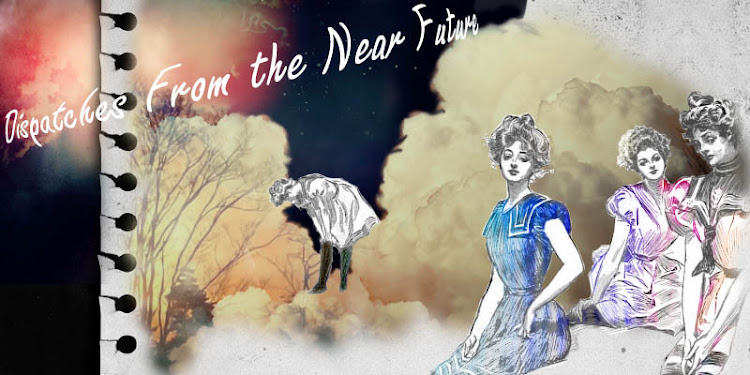From here on, this will be my glossary page. So I won't spam my page with constant glossary updates, I will continue to refer back to this one, mentioning in later posts when I have made additions or corrections. I intend to take examples from the many MANY books which Kiki (my professor) has shuttled into my little dressing room full of fun (ooh). I will make a weekly update on then glorious headgear of the 1840's come Friday.
Glossary:
Bavolet— Gathered back neck curtain of bonnet.
Boater—A still oval straw hat coated with shellac, fashionable from the end of the 19th century.
Bonnet—A soft head covering with ties.
Buckram—A coarse cotton fabric heavily sized with glue, used for stiffening garments and in bookbinding.
Calash—A 17th century head covering which shields the entire head and face from sun and rain. Often constructed around whalebone or cane hoops, covered in fabric. Does not require hair to be dressed.
Cap—An integral part of dress throughout the 18th and 19th centuries. They were worn at all times of day. Both indoor and outdoor styles.
Capote—Bonnet with stiff projecting brim framing the face, soft gathered fabric crown, and ribbons tied at one side.
Capstrings—The long ribbons of a bonnet that tie under the chin (usually in a bow)
Chingnon—A large knot of hair worn at the back of the head. Popular at various times. During the 19th century it often weighed 5 ounces.
Chip—Thin strips of wood used like straw and woven into ladies’ hats and bonnets.
Cirè—Fabric given shine with the use of wax.
Coiffure—A style of arranging the hair. (Picture to follow)
Cottage bonnet—A straw bonnet with a brim projecting beyond the cheeks. Popular from 1808, it was modified during the century, the bring being lined and rolled backwards.
Crêpe—A pad with tapered ends formerly used in women’s hair styles to give the appearance of greater thickness.
Devonshire Hat—A very large, wide-brimmed hat, generally trimmed, with a deep crown. Made populate by Thomas Gainsborough’s portrait of Georgiana, Duchess of Devonshire. Also known as ‘picture hat’. The style reappeared in the late 19th century.
Dormeuse—Indoor or night-time (dormouse) cap of muslin, lawn or linen, fitting loosely over the coiffure.
Drawn Bonnet—Refers to several types of ladies bonnets constricted by gathering a fine material over hoops or half-hoops of cane, reed, or wire.
Elastic—Cord, thread, or string woven with india-rubber. Invented in 1820 by an Englishman, T. Hancock.
Fanchon—A small, lace-edged kerchief used as head-dressing or trimming over the ears of a day bonnet from 1830’s.
Fanchon cap—Lace or tulle bonnet with deep ruffle at the back of the head from 1840s.
Findings—Jewelry fittings: clasps, rings, etc.
Florentine Hat—Made from fine straw from Tuscany, cut green and bleached.
Gipsy bonnet—Rather flat, open bonnet style with a short brim with ends coming to points at or below chin level but tying under back hair; ribbon strings tied under chin. Popular from 1840’s-1850’s.
Grosgrain—Hard-wearing corded silk fabric.
Hood—Performs the same function as a calash. Quilted silk encompasses the head. Varies in length.
Imperatrice—1850’s-1860’s style referring to Empress Eugenie of France. While the term refers to her particular style, this includes hats and hair.
Lisse—Fine, sheer, plain-weave silk crepe.
Lappet—A piece of fabric or pairs of pendant strips made of ribbon, fabric or lace hanging from the head-covering, bonnet, or gable hood.
Lunardi Hat—A large hat with a crown of puffed gauze, named after Vincenzi Lunardi, who made the first manned flight in a balloon in Great Britain in 1784.
Nankeen—Firm, closer-woven glazed cotton, of a yellowish-tan color, with no size or bleach, used for linings or facings.
Net—Openwork fabric in mesh of various sizes; originally made by hand with a netting tool, and later machine made.
Pamela bonnet—Straw trimmed with flowers on a sloping brim tied with ribbons, named in 1845 after Samuel Richardson’s 18th-century eponymous heroine Pamela.
Pamela hat—Low-crowned, straight-brimmed straw hat for girls and young women. Also has a short veil, gathered and hanging from the brim. Popular in the 1850’s and 60’s.
Phrygian Bonnet—Pointed cap, usually fitted over ears.
Plaits—Wound and plaited straw, used in hats and bonnets in the 17th, 18th,and 19th centuries.
Point Lace—Lace made with a needle.
Quaker Bonnet—Also known as the Wagon Bonnet from its resemblance to a covered wagon.
Ruche—To draw up on thread, especially to draw up a narrow bias strip of fabric on a center of line of stitching or cording.
Spoon Bonnet—Narrow brim at the sides rising high above the face in a spoon-shaped curve, sloping down at the back and edged with a bavolet, 1860s.
Tatting—A kind of lace made by hand with a small shuttle; most often consisting of circular elements.
Toque—Small, close-fitting, brimless hat. Formerly, black velvet cap with full crown and small, rolled brim, ornamented with plumes; worn by men and women in France in the 16th century.
Tulle—Fine silk net originally from Tulle, France.
Ugly—Folding brim worn in front of a bonnet for protection against the sun, from 1848.
Wideawake Hat (m)—A stiff black felt hat with a deep crown and stiff, rather wide brim; especially popular for men and boys in the 1850’s.
Bibliography
Dreher, Denise. From the Neck Up. United States, 1981: Madhatter Press
Mackenzie, Althea. Hats and Bonnets. Great Britain, 2004: The National Trust
Severa, Joan. Dressed for the Photographer. Kent, Ohio, 1995: The Kent State University Press
Severa, Joan. My Likeness Taken. Ken, Ohio, 2005: The Kent State University Press


No comments:
Post a Comment